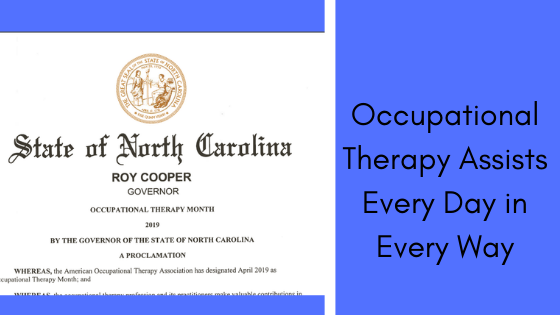While most medical services are focused on helping the patient live with/overcome a specific injury, Occupational Therapy (OT) is the only profession that helps people to continue to do the things they want and need to do throughout their lifespan.
This is accomplished through a holistic view. Occupational Therapy addresses the physical, psychological, and cognitive aspects of patient well-being through engagement in occupation. OT helps people function not only at home but also in work, school, and community environments.
For example, a common occupational therapy intervention for children with disabilities is helping them to participate fully in school and social situations.
OT is often confused with Physical Therapy (PT). Both educate people on how to prevent and avoid injuries. Both educate people about the healing process.
Where PT focuses on improving a patient’s ability to perform movement of the human body after an injury (strengthen leg after a fall), the focus of OT is on adapting the environment and/or task to fit the person (helping to live life to its fullest by promoting health, and living better with the leg injury).
Occupational therapy services typically include:
- an individualized evaluation, during which the client/family and occupational therapist determine the person’s goals,
- customized intervention to improve the person’s ability to perform daily activities and reach the goals, and
- an outcomes evaluation to ensure that the goals are being met and/or make changes to the intervention plan.
April is, of course, Occupational Therapy month. North Carolina Governor Roy Cooper issued a proclamation in honor of the event. Included among his words of praise were “…the health and productivity of the people of our state depend in part on the effective use of health care resources, including the important services of occupational therapists and occupational therapy assistants…” What can you do for OT month? There was an interesting article in the Midland Daily News of Michigan titled “It’s a good time to learn more about occupational therapy.” It reveals one of the therapy methods of OT is to treat these patients with dignity & respect by using person-first language.
“For example, when referring to someone diagnosed with autism, you should say ‘the child with autism.’ Using person-first language is necessary because the way we speak has a lasting impact on the attitudes and beliefs of society. If referring to a child with autism as the ‘autistic child,’ we are labeling them and emphasizing their diagnosis over their status as a person. By using person-first language in conversations and on social media, we ensure people are recognized as unique individuals, not their diagnoses.”
Recognizing these patients as “unique individuals, not their diagnoses” will go a long way in helping deal every day in every way with life.
For more information, contact the NC Occupational Therapy Association in Raleigh; it is North Carolina’s leading association for occupational therapists, occupational therapy assistants and occupational therapy students. The number is 919-785-9700.
This article was written by Anthony Scialis, Content Writer for Customer Engagement Specialist. You can follow Anthony on LinkedIn, Twitter, or find him blogging about social media marketing on WordPress.

